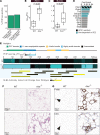Validation of a murine proteome-wide phage display library for identification of autoantibody specificities
- PMID: 37934865
- PMCID: PMC10795829
- DOI: 10.1172/jci.insight.174976
Validation of a murine proteome-wide phage display library for identification of autoantibody specificities
Abstract
Autoimmunity is characterized by loss of tolerance to tissue-specific as well as systemic antigens, resulting in complex autoantibody landscapes. Here, we introduce and extensively validate the performance characteristics of a murine proteome-wide library for phage display immunoprecipitation and sequencing (PhIP-seq) in profiling mouse autoantibodies. This library was validated using 7 genetically distinct mouse lines across a spectrum of autoreactivity. Mice deficient in antibody production (Rag2-/- and μMT) were used to model nonspecific peptide enrichments, while cross-reactivity was evaluated using anti-ovalbumin B cell receptor-restricted OB1 mice as a proof of principle. The PhIP-seq approach was then utilized to interrogate 3 distinct autoimmune disease models. First, serum from Lyn-/- IgD+/- mice with lupus-like disease was used to identify nuclear and apoptotic bleb reactivities. Second, serum from nonobese diabetic (NOD) mice, a polygenic model of pancreas-specific autoimmunity, was enriched in peptides derived from both insulin and predicted pancreatic proteins. Lastly, Aire-/- mouse sera were used to identify numerous autoantigens, many of which were also observed in previous studies of humans with autoimmune polyendocrinopathy syndrome type 1 carrying recessive mutations in AIRE. These experiments support the use of murine proteome-wide PhIP-seq for antigenic profiling and autoantibody discovery, which may be employed to study a range of immune perturbations in mouse models of autoimmunity profiling.
Keywords: Adaptive immunity; Antigen; Autoimmune diseases; Autoimmunity; Immunology.
Conflict of interest statement
Figures




Update of
-
Validation of a murine proteome-wide phage display library for the identification of autoantibody specificities.bioRxiv [Preprint]. 2023 Apr 7:2023.04.07.535899. doi: 10.1101/2023.04.07.535899. bioRxiv. 2023. Update in: JCI Insight. 2023 Dec 8;8(23):e174976. doi: 10.1172/jci.insight.174976. PMID: 37066405 Free PMC article. Updated. Preprint.
References
Publication types
MeSH terms
Substances
Grants and funding
LinkOut - more resources
Full Text Sources
Other Literature Sources
Molecular Biology Databases
Miscellaneous

